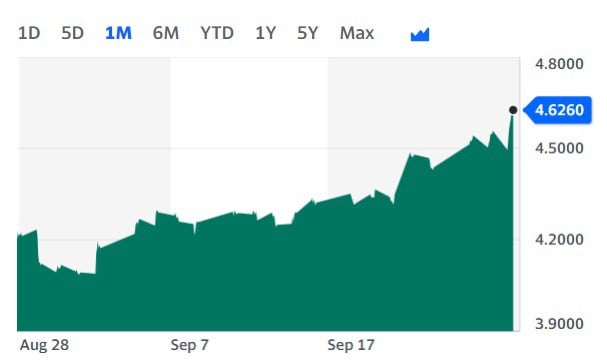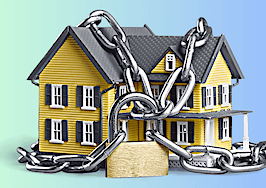No one can predict the future of real estate, but you can prepare. Find out what to prepare for and pick up the tools you’ll need at Virtual Inman Connect on Nov. 1-2, 2023. And don’t miss Inman Connect New York on Jan. 23-25, 2024, where AI, capital and more will be center stage. Bet big on the future and join us at Connect.
Homebuyer demand for mortgages eased last week as mortgage rates climbed to highs not seen in two decades — a trend that’s continued this week, even as the threat of a government shutdown looms.
The Mortgage Bankers Association’s weekly survey of lenders showed applications for purchase loans fell by a seasonally adjusted 2 percent last week when compared to a week earlier, the first drop since the week ending Sept. 1. Looking back a year, purchase loan applications were down 27 percent.
Although Federal Reserve policymakers voted not to raise short-term interest rates last week, they released projections indicating one more rate increase could be required to get inflation under control, followed by a longer period of higher rates than previously projected.
The Fed’s “higher for longer” rate strategy drove yields on long-term Treasurys higher, and mortgage rates followed, said MBA Deputy Chief Economist Joel Kan.

Joel Kan
“Mortgage rates moved to their highest levels in over 20 years as Treasury yields increased late last week,” Kan said in a statement. “The 30-year fixed mortgage rate increased to 7.41 percent, the highest rate since December 2000, and the 30-year fixed jumbo mortgage rate increased to 7.34 percent” — the highest since the MBA started tracking jumbo rates in 2011.
Both would-be homebuyers and homeowners continue to feel the impact of elevated rates, Kan said, with applications to refinance down 21 percent from a year ago because many homeowners have little incentive to refinance.
Mortgage rates edging back up
The Optimal Blue Mortgage Market indices, which were launched in 2017, show rates on 30-year fixed-rate conforming loans hitting an all-time high of 7.38 percent Tuesday.
Freddie Mac’s rate surveys, which date back to 1971, show rates hitting a 2023 peak of 7.23 percent during the week ending Aug. 24, the highest level since June 2001, a level that’s likely to be surpassed when the next survey is released on Sept. 28.
While Fed policymakers are looking for signs that inflation is easing, forecasters at Pantheon Macroeconomics have noted several events that are beyond the Fed’s control which could dent growth: A United Auto Workers strike targeting the big three U.S. automakers, the resumption of federal student loan payments in October, and the growing likelihood of a government shutdown.
With Speaker of the House Kevin McCarthy still short of the needed votes to pass a short-term spending bill Wednesday, it’s looking “inevitable” that the government will shut down this weekend, Politico reported.
“The stock market is reacting just as badly to the prospect of a shutdown as in December 2018,” Pantheon forecasters noted Tuesday in their latest U.S. Economic Monitor report Tuesday. “Markets probably are right to be nervous about the potential impact of an extended shutdown, but they are worried too — as are we — that the Fed has gone too far” in raising interest rates.
10-year Treasury yields surge to new 2023 high

Yields on 10-year Treasury notes, a barometer for mortgage rates, surged to a new 2023 high of 4.64 percent Wednesday, a level not seen since 2007.
Futures markets tracked by the CME FedWatch Tool put the probability of one or more additional Fed rate hikes this year at 42 percent, and only a 5 percent chance that the Fed will bring rates back down below current levels by March, before the spring homebuying season kicks off.
For the week ending Sept. 22, the MBA reported average rates for the following types of loans:
- For 30-year fixed-rate conforming mortgages (loan balances of $726,200 or less), rates averaged 7.41 percent, up from 7.31 percent the week before. Although points decreased to 0.71 from 0.72 (including the origination fee) for 80 percent loan-to-value ratio (LTV) loans, the effective rate also increased.
- Rates for 30-year fixed-rate jumbo mortgages (loan balances greater than $726,200) averaged 7.34 percent, up from 7.32 percent the week before. Although points decreased to 0.78 from 0.80 (including the origination fee) for 80 percent LTV loans, the effective rate also increased.
- For 30-year fixed-rate FHA mortgages, rates averaged 7.16 percent, up from 7.08 percent the week before and the highest level since March 2002. With points increasing to 0.96 from 0.92 (including the origination fee) for 80 percent LTV loans, the effective rate also increased.
- Rates for 15-year fixed-rate mortgages, popular with homeowners who are refinancing, averaged 6.73 percent, up from 6.62 percent the week before and the highest level since July 2001. With points increasing to 1.17 from 1.08 (including the origination fee) for 80 percent LTV loans, the effective rate also increased.
- For 5/1 adjustable-rate mortgages (ARMs), rates averaged 6.47 percent, up from 6.42 percent the week before. With points increasing to 1.58 from 1.10 (including the origination fee) for 80 percent LTV loans, the effective rate also increased.
Get Inman’s Mortgage Brief Newsletter delivered right to your inbox. A weekly roundup of all the biggest news in the world of mortgages and closings delivered every Wednesday. Click here to subscribe.












